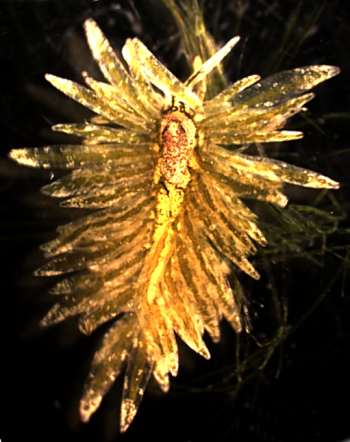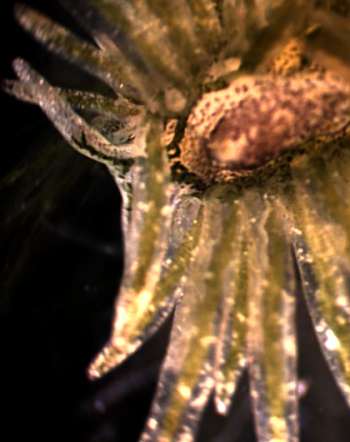

Placida kingstoni
Thompson, 1977
Order: SACOGLOSSA
Superfamily: LIMAPONTIOIDEA
Family: Limapontiidae
DISTRIBUTION
Caribbean
PHOTO
In shallow water near the shore of Tampa Bay, Florida by Nick Curtis, January 2004. On Bryopsis. Approx 2 cm long. Photo: Julie A. Schwartz
The body wall is translucent with scattered brown spots, and sometimes white spots as well. The viscera show through the skin. The cerata are long. The ceratal wall is translucent clear with some scattered white speckling and a brown tip. There is an unbranched green duct of the digestive gland in each ceras. On the head, a dark green branch of the digestive gland runs along each side giving off ducts to each of the anterior cerata and to the rhinophore on its side. On the ventral side of the rhinophore the basal half is clearly enrolled, but the upper half forms a solid tapering cylinder [see photo]. One characteristic behaviour of this species is that the cerata pulsate. Grows to approx 20mm long.
Originally described from Jamaica, it has been reported from Florida by Kathe Jensen (1981) who studied its feeding on Bryopsis plumosa. She describes a strange behaviour in which the slug sucks the cell sap out of the algal filaments and then it returns back into the algal filament before being resucked into the slug again. This process can be repeated two or three times before eventually being pumped into the stomach.
References:
• Jensen, K.R. (1981) Observations on feeding methods in some Florida ascoglossans. Journal of Molluscan Studies, 47: 190-199.
• Thompson, T.E. (1977) Jamaican opisthobranch molluscs I. Journal of Molluscan Studies, 43(2): 93-139, pls.1-3.
Rudman, W.B., 2004 (January 22) Placida kingstoni Thompson, 1977. [In] Sea Slug Forum. Australian Museum, Sydney. Available from http://www.seaslugforum.net/factsheet/placking
